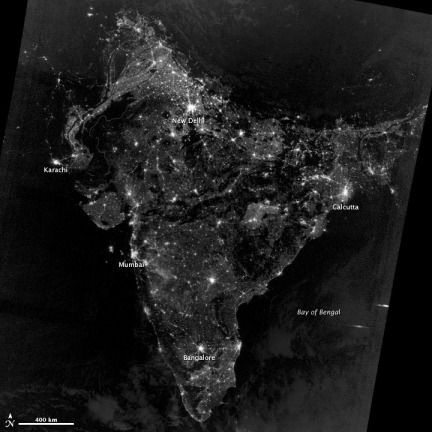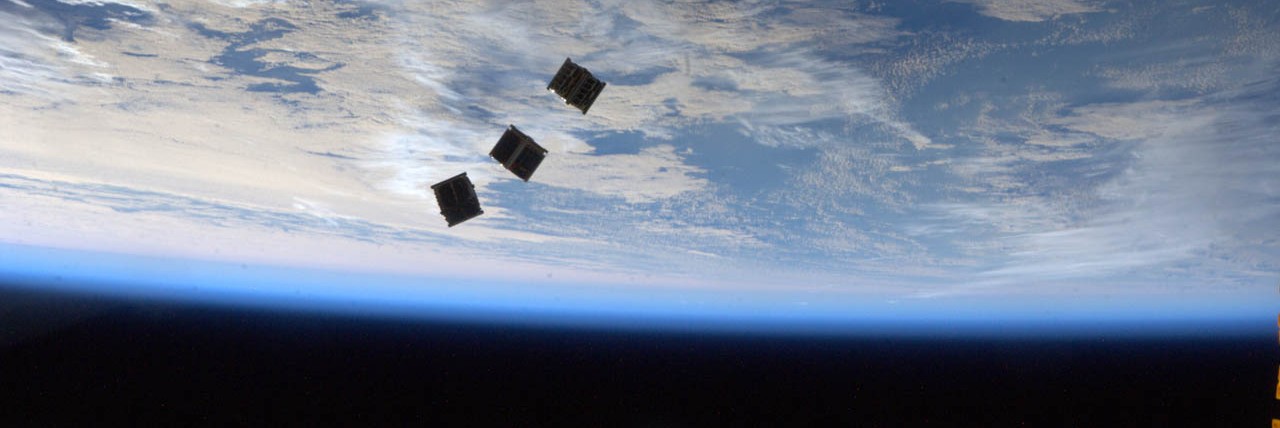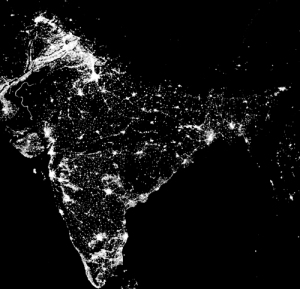स्पेस शटल प्रोग्राम
मानवाला आकाशाचे आकर्षण फार पूर्वीपासून आहे. गेल्या अनेक शतकांपासून आकाशात दिसणार्या, उडणर्या गोष्टींची निरीक्षणे मानवाने केली. त्यातील सर्वात आकर्षक गोष्ट म्हणजे आकाशात उडणे. १९ व्या शतकात विविध साधनांच्या सहाय्याने माणूस उडू लागला. या पुढचे आकर्षण म्हणजे आकशात वास्तव्य. माणसाची अवकाशात रहाण्याची सोय एका मानवनिर्मित उपग्रहवर करण्याचा खटाटोप ५० वर्षापूर्वी झाली.
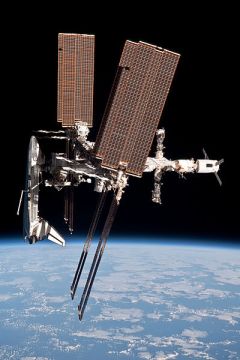
“इंटरनॅशल स्पेस स्टेशन”ला (डॉक) जोडलेले इंडेव्हर यान
तत्कालीन सोविअत युनिअनने गुप्त सैनिकी प्रकाल्पने यास सरुवत झाली. “अल्माज़” नावाचा हा गुप्त प्रकल्प पुढे “सेलूट” (१९७१ ते १०८२) नावाच्या स्पेस स्टेशन प्रकल्पाचा भाग झाला. रशियाने त्यानंतर काही वर्षात मीर स्पेस स्टेशन प्रकल्प चालू केला. इकडे अमेरिकेने सुधा त्याच काळात स्कायलॅब स्पेस स्टेशनचे काम सुरु केले. यानंतर अमेरिकेने इतर १५ देशांच्या सहकर्याने सर्वात महत्वकंशी इंटरनॅशल स्पेस स्टेशन (ISS) अवकाशात बंधण्यास सुरुवात केली. यात नासा, रशियन फेडेरल स्पेस एजंसी, जापानीज़ स्पेस एक्स्प्लोराशन एजंसी, यूरोपियन स्पेस एजंसी, कनाडियन स्पेस एजंसी यांचा सहभाग आहे. ISS सुमारे ३३० किमी ते ४१० किमी उंचीवारून पृथ्वीभोवती एका दिवसात १५.७ वेळा प्रदक्षिणा मारत आहे. मानवाला अंतराळत कसे रहता येईल याचे उत्तर शोधणे हे स्पेस स्टेशनच्या प्रमुख उद्दिष्टांपैकी आहे. यासाठी ISS वर जीवशास्त्र, मानवी जीवशास्त्र, भोतिकशास्त्र, खगोलशास्त्र, हवामानशस्त्र, पृथ्वीचा भुगोल अशा वेगवेगळ्या विषयात संशोधन केले जाते.
ISS ला लागणारे साहित्य आणि अंतराळवीर यांची ने-आण करण्यासाठी रशियाकडे सोयुज़, प्रोग्रेस, ऑटोमेटेड ट्रान्सफर वेहिकल, H -II ट्रान्सफर वेहिकल आहेत. तर अमेरिकन सरकारने नासाचा स्पेस शटल प्रोग्राम १९८१ साली हाती घेतला. ३० वर्षे चाललेल्या या प्रकल्पचे official नाव ’स्पेस ट्रांसपोर्ट सिस्टम’ (STS) असे होते. जुलै २०११ पर्यन्त १३५ स्वार्या आखल्या गेल्या. सॉलीड रॉकेट बुस्टर, एक्स्ट्रा टँक आणि ऑर्बिटर वेहिकल हे स्पेस शटलचे प्रमुख भाग असतात. यातील ऑर्बिटर वेहिकल महत्वाचा आणि परत परत वापरता येणारा भाग असतो. रॉकेट, स्पेसक्राफ्ट, एअरक्राफ्ट यांच्या मिश्रणातून ऑर्बिटरची बांधणी केली गेली. नासाने अनुक्रमे एंटरप्राइज, कोलंबिया, चॅलेंजर, डिस्कवरी, अटलांटिस, इंडेव्हर अशा सहा ऑर्बिटर बांधले त्यापैकी एंटरप्राइजला सुरुवतीच्या काही परिक्षणानंतर ऑक्टोबर १९७७ सली निवृत्त केले गेले.
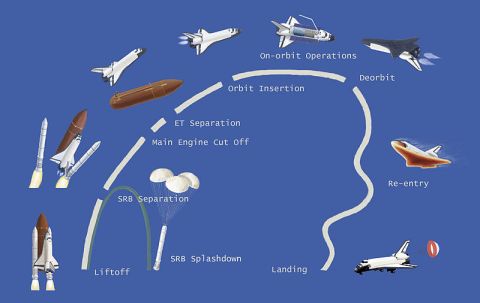
त्यामुळे खर्या अर्थाने पहिले उड्डाण STS-१ कोलंबियाने १२ एप्रिल १९८१ रोजी केले. स्पेसलॅब, मायक्रोग्रॅव्हिटी या प्रयोगांमधे कोलंबियाचा सहभाग होता. चंद्रा नावच्या क्ष-किरण दुर्बिणीला अवकाशात सोडणे आणि हबल दुर्बीणीच्या दुरुस्ती मोहेमेसाठी या ऑर्बिटरचा वापर केला गेला. एकूण २७ मोहिमा फत्ते झाल्यानंतर २८वी मोहीम (STS-१०७) पूर्ण करून कोलंबिया १ फेब्रुवारी २००३ ला पृथ्वीवर परतणार होते, पण दुर्दैवाने सात अंतरळवीरांसह दुर्घटनाग्रस्त होवून नष्ट झाले.
चॅलेंजर यानाचा वापर एप्रिल १९८३ साली (STS-६) मोहेमेमधे करण्यात आला. स्पेस शटल प्रोग्रॅममधे पहिल्यांदा ’स्पेसवॉक’ याचवेळेस केला गेला. स्पेसलॅबचे बांधकाम, दूरसंचार उपग्रह सोड्ण्याचे काम या यानाने केले. काही महिला अंतरळवीरांच्या सहभागाने चॅलेंजरच्या मोहीमा उल्लेखनीय ठरल्या. अखेरीस दहव्या मोहिमेच्या वेळेस २८ जानेवारी १९८६ रोजी (STS-51-L) शटलच्या उड्डाणानंतर १ मिनीट १३ सेकंदात अपघात होवून सात अंतरळवीर मृत्युमुखी पडले.
ऑगस्ट १९८४ मधे डिस्कवरी यान (STS-41-D) पहिल्यांदा अवकाशात झेपावले. यानाची तिसरी मोहीम ही चॅलेंजरच्या अपघातानंतर असल्यामुळे महत्त्वाची आणि यशस्वी ठरली. २७ वर्षांच्या कारकिर्दीत या यानाने ३९ मोहीमा फत्ते केल्या, सर्वांत जास्त म्हणजे एकूण ३६५ दिवस अवकाशात घालवले. तेरा वेळा ISS ला अवकाशात जोडले गेले. सर्वात वयस्कर अंतरळवीर जॉन ग्लेन हे वयाच्या ७७ व्या वर्षी डिस्कवरीने प्रवास केला. हबल अंतराळ दुर्बिणीला पृथ्वीभोवती कक्षेत स्थिरवण्याचे काम डिस्कवरीने केले.
अटलांटिस १९८५ साली (STS-51-J) या मोहिमेअंतर्गत अमेरिकेच्या संरक्षण, दूरसंचार उपग्रह अवकाशात सोडण्यात आले. दुसर्या ग्रहांवर जाणार्या Probes साठी याचा वापर करण्यात आला. ISS च्या बांधणीचे बरेच काम या यानाने केले. अटलांटिसचे शेवटचे उड्डाण लक्षात रहण्यासारखे आहे. नासाच्या स्पेस शटल कार्यक्रमची सांगता (STS-१३५) २१ जुलै २०११ रोजी केनेडी स्पेस सेंटर, फ्लोरीडा येथे झाली. अटलांटिसने पृथ्वीभोवती ४,८४८ वेळा घिराट्या घातल्या आणि यासठी अंतरळात ३०६ दिवस रहून एकूण 203,000,000 किमी प्रवास केला.
इंडेव्हर हे शेवटचे ऑर्बिटर वेहिकल चॅलेंजर यानाचा अभाव भरून काढण्यासाठी वापरले गेले. या यानाचे नाव हे अमेरीकेतील विद्यार्थ्यांनी सुचविले. इंडेव्हर हे नाव कॅ. जेम्स कूक यांच्या जहाजचे होते. कॅ. कूक यंनी १७६९ साली शुक्राचे अधिक्रमण पाहण्यास इंडेव्हर जहाजाने मोठ प्रवास केला होता. स्पेस शटल कार्यक्रमची शेवटुन दुसरी मोहीम (STS-134) १ जुन २०११ रोजी संपली आणि ये यान निवृत्त झले. अटलांटिस प्रमाणेच हबल अंतराळ दुर्बिणीची दुरुस्ती, स्पेस्लॅबचे प्रयोग, मीर स्पेस स्टेशनचे आणि ISS च्या बांधणीचे काम यशस्वीरीत्या पार पाडले. इंडेव्हर अवकाशात एकूण २९९ दिवस होते. सर्व यानांपैकी मोठी मोहीम इंडेव्हरने केली. – १६ दिवस, १५ तास, ८ मिनीट, ४८ सेकंद..!
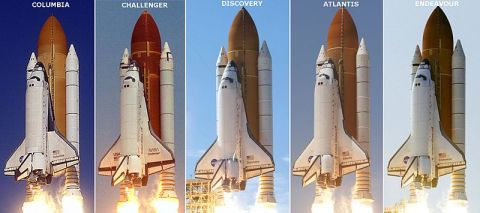
निवृत्त झल्यानंतर
एका नंतर एक यान निवृत्त झाल्यानंतर, यानांचे काही भाग सुटे करुन काही संस्थाना देण्यात येतील तर कही संग्रहालयात ठेवण्यात येतील.
उष्णतारोधक विटा – एका यानाला सधारण ७००० विटा वापरण्यात आल्या होत्या. नासाने शैक्षणिक संस्थांना अशा विटा संग्रहासाठी दिल्या. एका विटेची किंमत २३.४० अमेरिकन डॉलर एवढी होती.
मुख्य इंजीन – स्पेस शटल प्रोग्रॅमसठी RS25/26 नावाचे एकूण ४२ इंजीन वापरण्यात आले. यापैकी ३ इंजीन ’हेवी लिफ्ट वेहिकल’ प्रोजेक्टसाठी देण्यात येतील.
यानाचा महत्त्वचा भाग म्हणजे रोबोटीक हात. कॅनडार्म नावाचा हा भाग ५० फुट लांब आहे. इंडेव्हर यानाचा हा हात काढुन कॅनडा स्पेस सेंटरच्या मुख्यालयात प्रदर्शनास ठेवण्यात येईल.
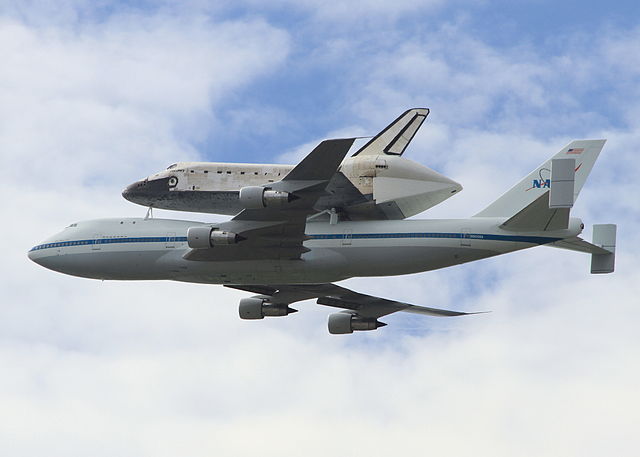
बोईंग-७४७ विमानाने डिस्कवरी यानास संग्रहालयापर्यंत नेले!
एप्रिल २०१२ हा महीना डिस्कवरी, एंटरप्राइज यानांच्या बातम्यांमुळे गाजला. कारण १९ एप्रिलला या यानाला कायमचे प्रदर्शनासाठी स्मिथसोनियन इन्स्टीट्युशनच्या व्हर्जीनिया येथील Steven F. Udvar-Hazy Center च्या नॅशनल सी – स्पेस संग्रहालयात आणण्यात आले. बोइंग कंपनीच्या ७४७ जेटलायनर विमानाला नासाने खास बदल करुन ऑर्बिटर वेहिकल वाहून नेण्यास तयार केले. ७४७ जेटलायनरच्या पाठीवर डिस्कवरी ऑर्बिटर वेहिकल ठेवून हा ऐतिहासिक विमानप्रवास केला गेला.
२००३ पासुन येथे असलेल्या एंटरप्राइज यानाची रवनागी एप्रिल २०१२ च्या शेवटच्या आठवड्यात न्यु-यॉर्क येथील इंटरप्रीड सी-एअर-स्पेस संग्रहालयात होइल.
अटलांटिस यान हे केनेडी स्पेस सेंटरच्या, केप कर्निवल, फ्लोरीडा येथील विझीटर कॉम्प्लेक्समधेच कायम ठेवण्यात येईल.
तर इंडेव्हर यान लॉस एंजेलीस येथील कॅलीफोर्निया सायन्स सेंटरला ओक्टोबर २०१२ ला हलवण्यात येईल.

